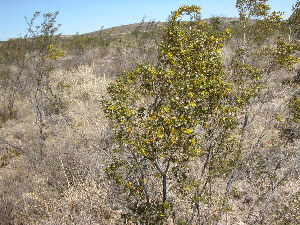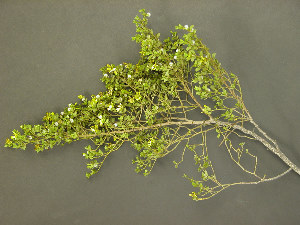Creosote Bush
Larrea tridentata (Sesse & Moc. ex DC.) Coville var. tridentata
Zygophyllaceae (Caltrop Family)
Creosote bush is an evergreen shrub that can grow to almost 10 feet in height. It is a widespread and often dominate component of the lower deserts across the southwest. Creosote bush had many medicinal uses to native peoples and other applications as well.
The yellow flowers of creosotebush can appear after a rain throughout the year, and the foliage gives off a powerful aromatic scent after a rain that is similar to the aroma of coal tar creosote, hence the common name creosotebush. In the Lower Pecos, creosotebush is far more widespread on the western side of the Pecos River, but it does occur in isolated patches to the east (Mabry et al. 1977; Powell 1998). An insect that lives on creosotebush, Tachardiella larreae exudes a gum-like substance commonly referred to as lac (Mabry et al. 1977). In ethnobotanical or historical accounts lac is often referred to as gum or resin, and Native Americans put it to several uses.
Archeological occurrence. Creosote bush was identified in Late Archaic deposits recovered from Hinds Cave (Dering 1979). More recently complete branches of creosote were identified in well-preserved archeological deposits of Tres Metates rockshelter in Presidio County (Dering 2006).
Chemical composition. Creosote bush resin contains 83 to 91 percent phenolic compounds, including flavonoids and nordihydroguaiaretic acid as well as waxes and other compounds. The phenolic compounds are quite active in mammalian systems, and creosotebush is studied for both its toxic and healing properties. It can be toxic to herbivores and exhibits allelopathic activity, which means that the chemicals in creosotebush roots and leaves inhibit the growth of other plants (Mabry et al. 1977). Creosote bush is utilized to produce certain herbal medicines that are argued by some to heal many types of viral infections, and is an anti-inflammatory that can be used to treat rheumatism and general aches and pains. Creosote bush appeared in the Pharmacopoeia of the United States throughout the last half of the 19th century and the first half of the 20th century, used for its antiseptic qualities. That said, the medicinal qualities of creosotebush remains a somewhat controversial topic today, and so I will limit my specific comments primarily to Native American uses of the plant.
Medicine. Creosote bush was used primarily for pharmacological applications. Curtin (1949:62) reports that the members of the Women's Club on the Salt River Reservation said that "this plant cures everything, and that's what nature gave us." That is quite a testimony, so let's explore the many medicinal uses of creosote. Once again, I caution the reader to not try any of these remedies without professional consultation; creosotebush contains quite an array of powerful chemicals that can cause damage. Any medicine can be dangerous if improperly used.
Respiratory ailments. Both the crushed leaves and lac are utilized to treat respiratory ailments. These include the common cold, a sore throat, and tuberculosis. For the common cold, the Pima prepared a decoction of the lac, and the Cahuilla used an infusion of the leaves. It was also used as a decongestant, and the steam rising from boiling the leaves was inhaled by the Cahuilla and the Hualapi. The Pima used a decoction of the lac to treat tuberculosis. (Bean and Saubel, 1972; Curtin 1949). Sore throats were treated using a decoction of the leaves as a gargle.
Anti-inflammatory, anti-rheumatic. Creosote is used to treat aches and pains of both the joints and muscles. The Diegueno, the Cahuilla, the Pima, the Papago, and the Yavapai all claimed that creosote had anti-inflammatory, analgesic qualities. Application varies from bathing in a decoction of the leaves to applying a poultice to the sore area. The Pima heated the leaf-bearing branches and bound them to the part of the body that was in pain. The Cahuilla made the leaves into a liniment. (Castetter and Underhill 1935; Gifford 1936; Hedges and Beresford 1986).
Gastrointestinal. Here we get into more delicate applications of this herb. The Papago, Pima, and the Cahuilla all used it to treat various forms of gastric upset. Both the lac and the leaves were made into decoctions or infusions and administered orally. There are specific mentions of its use for its calming effects on the bowels (Bean and Saubel 1972; Curtin 1949). However, in some cases they used it as an emetic; the distinction is apparently related to dosage (Bean and Saubel 1972; Russell 1908). Thus there may have been a fine line between the calming effects and some very disturbing effects on the bowels.
Skin. Poultices, decoctions, and infusions of the leaves and lac were utilized to treat a broad range of skin disorders, as well as cuts, abrasions, and boils. Some disorders also were treated by applying the dried and pulverized leaves. It is apparent that creosotebush had both antiseptic/disinfectant and astringent capabilities. Pima and the Cahuilla used infusions or poultices to treat wounds and skin abrasions. The Pima also used creosote to treat skin diseases such as impetigo. The Cahuilla applied a powder made from the leaves to wounds for its antiseptic qualities. The Pima applied the powder to a newborn's navel to promote healing (Bean and Saubel 1972; Curtin 1984). The Pima applied the powder and the leaves to the skin and feet as a deodorant (Curtin 1949).
Miscellaneous. Creosote bush leaves were used for general oral health, including as a treatment for toothaches by the Pima (Curtin 1949). Also, the Pima used the decoction to treat fevers, to treat dandruff, to treat gas, and to treat saddle sores on horses.
Tools. The lac was used to haft various tools by the Cahuilla, the Panamint, and the Kawaiisu (Bean and Saubel 1972; Kirk 1952; Zigmond). The Papago used creosote wood to fashion small arrow shafts for small game, and to make foreshafts for war arrows (Castetter and Underhill 1935).
References:
Bean, Lowell J. and Katherine S. Saubel
1972 Temalpakh: Cahuilla Indian Knowledge and Usage of Plants. Malki Museum Press. Morongo Indian Reservation, Banning, California.
Castetter, Edward F. and Ruth Underhill
1935 The Ethnobiology of the Papago Indians. Ethnobiological Studies in the American Southwest. Vol. II. The University of New Mexico Bulletin, Biological Series 4(3). Albuquerque, New Mexico.
Curtin, Leonora Scott Muse
1949 By the Prophet of the Earth: Ethnobotany of the Pima. San Vicente Foundation, Sante Fe, New Mexico. [1984 reprint, University of Arizona Press, Tucson.]
Dering, J. Philip
1979 Pollen and Plant Macrofossil Vegetation Record Recovered from Hinds Cave, Val Verde County, Texas. Unpublished Masters Thesis. Texas A&M University. College Station, Texas.
2006 Plant Remains from 41PS915, Tres Metates, a Rockshelter in Presidio County. Report submitted to the Center for Big Bend Studies, Sul Ross State University. Alpine, Texas.
Gifford, Edward Winslow
1936 Northeastern and Western Yavapai. University of California Publications in American Archaeology and Ethnography. 34:247-354.
Hedges, Ken, and Christina Beresford
1986 Santa Ysabel Ethnobotany. San Diego Museum of Man -- Ethnic Technology Notes no. 20. San Diego, California.
Kirk, R. E.
1952 Panamint Basketry. The Masterkey 26:76-86.
Mabry, Tom J., J. H. Hunziker and D. R. Difeo, Jr. (eds.).
1977 Creosote Bush--Biology and Chemistry of Larrea in New World Deserts. Dowden, Hutchinson and Ross. Stroudsburg, Pennsylvania.
Powell, A. Michael
1998 Trees and Shrubs of the Trans-Pecos and Adjacent Areas. University of Texas Press, Austin.
Russell, Frank
1908 The Pima Indians. Twenty-sixth Annual Report of the Bureau of American Ethnology, [1904-1905], pp. 17-389. Washington, D.C.
Zigmond, Maurice L.
1981 Kawaiisu Ethnobotany. University of Utah Press. Salt Lake City, Utah.
![]()

